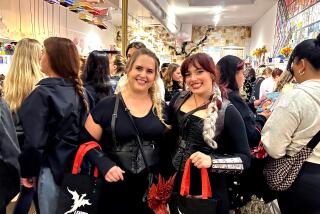Tips to Get the At-Home Group Going
- Share via
Many book groups start spontaneously, out of play groups, neighborhoods, churches, synagogues or among co-workers and find a magical chemistry all their own. But if you’re starting from scratch, you might consider the following:
* Think about a style. Do you want a structured or informal format or something in-between? They all work, but not for all people.
Less-structured groups are content to take 10 minutes of every meeting to choose the next month’s book and meeting.
“Someone just says, ‘Let’s get started’ and then it just goes from there,” says Danis Kreimeier, a Yorba Linda librarian. “Then we usually decide on the next book at that meeting. It’s pretty loose.”
Highly organized groups may have a book selection committee; paid discussion leaders or members willing to compose discussion questions, research the author’s biography and take turns leading discussions; a buyer who locates book discounts or library copies; and a secretary to manage administrative details, such as mailing lists, discussion summaries and schedules.
* What do you want to read? Will you focus on a theme, such as classics, contemporary novels, nonfiction, genre or ethnic literature? Or will you read a little of everything? Your group will still have to compromise occasionally, but if there’s a general direction you’re less likely to end up with a bunch of grumpy readers. “I don’t get science fiction!” “Another book about China?” “I want to read ‘Wuthering Heights.’ ” And so on.
The Morning Book Group of UC Irvine’s Town and Gown group thrives on themes. They spent a year on books about the Middle East, another on Southern writers. “It’s in-depth” that way, says member Mabry Steinhaus.
* Can my rambling, narrow-minded, chain-smoking sister-in-law who hates all books with sad endings join? Ah, new members. Every group handles this differently. Some are clubbish. Others keep an open door. Many groups report that their members “just know” who would fit in or that only those people who fit in are attracted in the first place.
Discuss it and figure out what’s in the group’s best interests. A variety of folks can spark the best discussions, so be careful not to get too homogeneous. But feel free to choose people with whom you feel comfortable and willing to express all those varied opinions.
* To eat or not to eat? Hardly a question, since most at least crack open some cookies. There are ambitious dinner party groups, a la Oprah Winfrey’s television specials. But most go for simple crunchy stuff, cheese, wine and mineral water followed by coffee and dessert.
* Have fun. One group has an old paperback gift exchange for the holidays. Many match snacks or background music to the book’s setting or characters. Try reading a book mentioned in a book.
A good pairing is “One True Thing” by Anna Quindlen and “Pride and Prejudice” by Jane Austen. Quindlen’s mother and daughter characters form a miniature-mother-daughter book group in a book and ruminate at length over the Austen classic.
* Avoid that baby-boomer affection for involving children in every adult event. Christine Moore of Hollywood abandoned one book group after the host’s child meandered among guests demanding rounds of tick-tack-toe.
Let kids say polite hellos and then scoot them off to bed or a sitter. Bribe them with promises of leftover cake. With luck, you’ll create a forbidden-fruit atmosphere and they’ll sneak off with pals and a box of Oreos to discuss the moral dilemmas in Madeline L’Engle’s “A Wrinkle in Time.”
Now, wouldn’t that be magical?
The Assn. of Book Group Readers and Leaders (ABGRL, P.O. box 885, Highland Park, IL 60035), offers more information.
More to Read
Sign up for our Book Club newsletter
Get the latest news, events and more from the Los Angeles Times Book Club, and help us get L.A. reading and talking.
You may occasionally receive promotional content from the Los Angeles Times.










